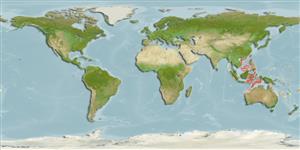Elasmobranchii (tubarões e raias) (sharks and rays) >
Carcharhiniformes (Ground sharks) >
Scyliorhinidae (Cat sharks) > Scyliorhininae
Etymology: Cephaloscyllium: cephalus, from kephale (Gr.), head, referring to its very broad and depressed head; skylion, Greek for dogfish or small shark. (See ETYFish); fasciatum: Latin for banded, referring to variegated color pattern of open saddles and circles with connecting dark lines. (See ETYFish).
Environment: milieu / climate zone / depth range / distribution range
Ecologia
marinhas associadas(os) a recifes; intervalo de profundidade 200 - 450 m (Ref. 106604). Deep-water; 21°N - 28°S
Western Pacific: East and South China seas (off South Taiwan, China, Philippines, Vietnam).
Comprimento de primeira maturação / Tamanho / Peso / Idade
Maturity: Lm ?, range 36 - ? cm
Max length : 42.0 cm TL macho/indeterminado; (Ref. 244)
This species is distinguished by the following characters: dorsal sides of body and fins with complex reticulations, with eight open-centered dark brown saddles on body, the first saddle immediately behind eye, second one above gill openings, the third above inner margin of pectoral fin, fourth saddle above middle between pectoral and pelvic finsl dorsal sides of pectoral and pelvic fins with a loop pattern (Ref. 94801).
Found in fairly deep water on or near the bottom on the outer continental shelf and uppermost slope (Ref. 244). Minimum depth from Ref. 58018. Can expand itself with air or water (Ref. 244). Oviparous (Ref. 50449). Size at sexual maturity according to literature and specimens studied, for males 36.0 cm and for females less than 42.1 cm with maximum size at least 421 cm TL (Ref. 80388).
Ciclo de vida ou comportamento de acasalamento
Maturities | Reprodução | Spawnings | Egg(s) | Fecundities | Larvas
Oviparous, paired eggs are laid. Embryos feed solely on yolk (Ref. 50449). Young hatch at about 12 cm (Ref. 6871).
Compagno, L.J.V., 1984. FAO Species Catalogue. Vol. 4. Sharks of the world. An annotated and illustrated catalogue of shark species known to date. Part 2 - Carcharhiniformes. FAO Fish. Synop. 125(4/2):251-655. Rome: FAO. (Ref. 244)
Status na Lista Vermelha da UICN (Ref. 130435)
Uso pelos humanos
Pescarias: pouco comercial
Ferramentas
Relatórios especiais
Baixar XML
Fontes da internet
Estimates based on models
Preferred temperature (Ref.
123201): 10.7 - 13.9, mean 12.3 °C (based on 63 cells).
Índice de diversidade filogenética (Ref.
82804): PD
50 = 0.5000 [Uniqueness, from 0.5 = low to 2.0 = high].
Bayesian length-weight: a=0.00263 (0.00139 - 0.00497), b=3.21 (3.04 - 3.38), in cm total length, based on LWR estimates for this (Sub)family-body shape (Ref.
93245).
Nível Trófico (Ref.
69278): 4.0 ±0.5 se; based on size and trophs of closest relatives
Resiliência (Ref.
120179): Baixo, tempo mínimo de duplicação da população 4,5 - 14 anos (Fec assumed to be <100).
Fishing Vulnerability (Ref.
59153): Low to moderate vulnerability (32 of 100).
